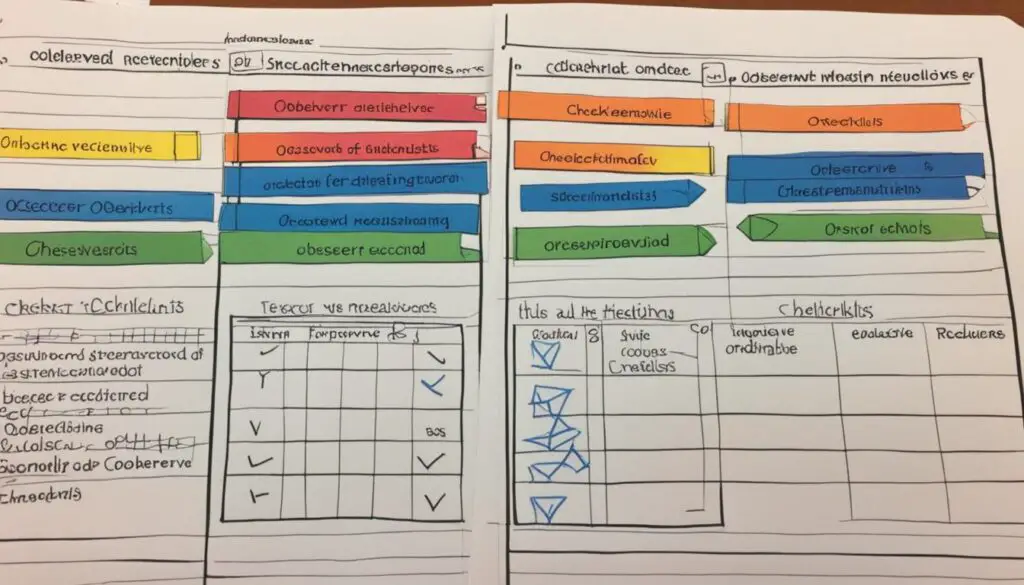Observing Human Behavior: Techniques for Effective Observation
As a researcher, I’m intrigued by how complex human behavior can be. We use many techniques to observe and understand it. Watching people is crucial in psychology and social sciences. It helps us learn a lot about how we act in different situations. I’ll dive into the ways we observe people to study their behavior.
Observational research is about systematically looking at and recording how people act. This way, we can describe and figure out why we do what we do. It lets us watch people in real life, seeing how they act in their everyday settings. By watching closely and taking notes, we see patterns and why we do things the way we do.
There are different ways to observe. Naturalistic observation means watching people in their normal settings without getting involved. You see natural behavior this way. It shows us how people truly act when they think no one is watching. This gives us a real look into daily life.
In participant observation, researchers join in with the group they’re studying. This method helps us see things from their perspective. It’s great for understanding complicated social situations or cultural behaviors. By being part of the group, researchers get insights they wouldn’t have otherwise.
Structured observation looks at specific actions in a controlled environment. The researchers decide what to observe and how. This method is good for experiments. It offers clear results that help prove or disprove ideas.
Key Takeaways:
- Observational research involves systematically observing and recording behavior to understand human behavior.
- Naturalistic observation involves observing behavior in the natural environment, while participant observation involves researchers becoming active participants in the group being studied.
- Structured observation focuses on specific behaviors in a controlled setting.
- Observational research is essential in psychology, anthropology, sociology, and education, providing insights into social interactions, cultural practices, and learning processes.
- By observing and studying human behavior, researchers can inform decision-making, improve products and services, and enhance our understanding of human interaction.
Types of Observational Research Methods
Observational research is a key way to learn about human behavior. It lets researchers watch and understand how people act and interact. We will look at three main methods: naturalistic observation, participant observation, and structured observation.
Naturalistic Observation:
Naturalistic observation means watching behavior in its real setting. Researchers don’t interfere. This way, they can see how people really act without changing anything. For example, a study might watch kids playing in a park.
Participant Observation:
In participant observation, the researcher joins the group they’re studying. They take part in activities to really get the feel of how things work. This helps them understand the group’s ways and build close relationships. They might take notes or interview people to gather information. This method is popular in studies of culture or society.
Structured Observation:
Structured observation is very controlled. Researchers focus on specific behaviors in set environments. This way, they get very detailed data. It’s often used in labs or classrooms, where everything can be controlled. This is good for studying behaviors that are hard to see naturally.
Each method has its own good points and bad points. Naturalistic observation is true to life but doesn’t control everything. Participant observation gives an insight but might be a bit one-sided. Structured observation collects data with control but might not apply broadly. Often, researchers mix these methods to get strong, reliable information.
The advantages and disadvantages of each observation method are summarized in the table below:
| Observation Method | Advantages | Disadvantages |
|---|---|---|
| Naturalistic Observation | Provides a realistic portrayal of behavior Allows for the study of behavior in natural settings |
Lacks control over variables Potential for observer bias |
| Participant Observation | Allows for gaining insider perspectives Enables in-depth understanding of social dynamics |
Potential for observer bias May influence the group’s behavior |
| Structured Observation | Allows for controlled data collection Enables focused analysis of specific behaviors |
May lack ecological validity Limitation in generalizability |
Using these methods helps researchers dive deep into how we act and interact. This increases our knowledge about social life, cultures, and thinking. Their uses span across many fields, like psychology, anthropology, sociology, and education.

The Importance and Applications of Observational Research
Observational research is important for understanding human behavior. It lets us watch and record how people act. This helps in seeing how we interact, grow, and think.
This method is key in psychology. It’s often used to look at social actions, thinking processes, and growth issues.
It’s not just for psychology, either. It’s used in anthropology, sociology, and education. These fields apply it to look at cultural activities, group actions, and how we learn.
For instance, anthropologists watch the daily life of a tribe to learn about its culture. Sociologists might study how people act in teams to understand social rules.
Observing product use is also important. Usability testing lets researchers see how people use things like websites or apps. This reveals what needs to be better, making things easier for the user.
In the end, observational research is valuable in many areas. It helps in making decisions, improving products, and better understanding human society. It’s an essential method that keeps growing our knowledge.
